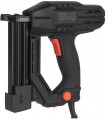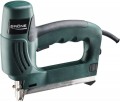Compatible staples
Staple models that the tool is compatible with.
Usually, quite specific options are indicated in this paragraph, so finding compatible consumables is not difficult. The specific dimensions of the fasteners should be specified according to the manufacturer's data — different brands use different markings.
Power consumption
The total power consumed by a mains-powered electric tool (see "Power Source"). It is considered the main criterion for assessing the overall capabilities of a particular model: more power leads to better performance. In addition, data on power consumption also allows you to estimate the load on the power grid or other power source; in some cases this is unnecessary.
Performance
The maximum output of a nailer/stapler is the maximum number of strokes it can produce in a minute. Note that in this case, the theoretical maximum is usually indicated — the highest speed of operation achievable under perfect conditions, in fact — the rate of operation of automation, which in many models exceeds 120 beats / min. In fact, this speed is difficult to achieve, because. the performance of the stapler is noticeably limited by the skills of the operator and the features of the functionality: for example, a tool with contact actuation (see below) must be pressed every time, which reduces the speed of work. However,
high performance clearly indicates good reliability and suitability for large volumes of work.
Max. staple width
The largest width of staples (see Fastener Type) that the stapler can work with.
The width of the bracket is, roughly speaking, the distance between its legs. Different situations and types of work require different sizes of staples, and sometimes the width must be quite large. However, a staple that is too large simply will not fit into the store, not to mention the fact that the stapler can “shoot” it normally. Therefore, this limit cannot be exceeded, and if you plan to work with brackets, you should pay special attention to the maximum width when choosing.
Staples included
The number of staples supplied with the stapler.
Construction staplers can be supplied with a stock of fasteners (staples, nails, pins) — so that you can immediately start working without buying more consumables. And knowing the number of such parts, you can not only determine how much the initial stock will last, but also evaluate how profitable the purchase of this model will be compared to the model without consumables in the kit. For example, a relatively expensive model that comes with 1,000 staples can end up being a better value than a cheaper tool that doesn't come with any hardware.
Nails included
The number of nails supplied with the stapler.
Construction staplers can be supplied with a stock of fasteners (staples, nails, pins) — so that you can immediately start working without buying more consumables. And knowing the number of such parts, you can not only determine how much the initial stock will last, but also evaluate how profitable the purchase of this model will be compared to the model without consumables in the kit. For example, a relatively expensive model that comes with 200 nails, as a result may be more profitable than a cheaper tool that does not come with any fasteners.
Case (bag)
The presence of a case or bag in the tool kit.
Such accessories are more convenient than impromptu packaging, they greatly simplify the storage and transportation of both the tool itself and accessories / consumables. At the same time, cases are the most popular in construction staplers — characteristic suitcases made of solid material. Such a suitcase perfectly protects the instrument not only from moisture and dirt, but also from shocks and shocks; it is also often used as the factory packaging in which the tool goes on sale. Bags made of soft material, in turn, are less common: they do not provide such protection against impacts, and they do not resist water / dust as effectively. On the other hand, such packaging itself is less bulky, and when the bag is not needed, it can be rolled up quite compactly.

